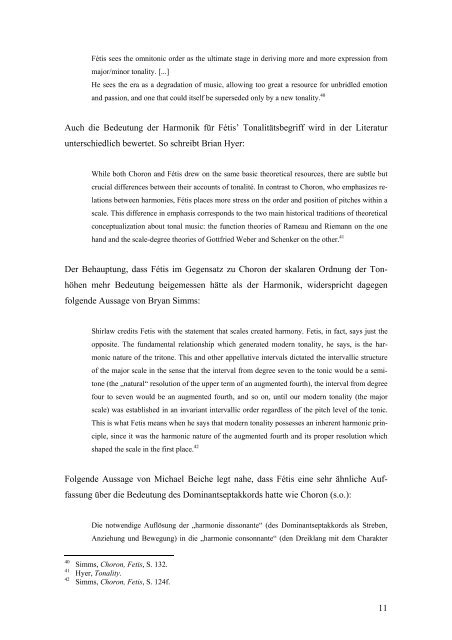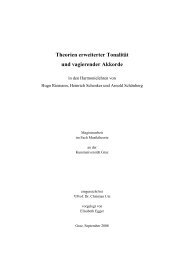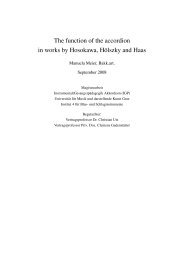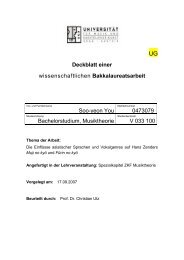Klangzentren und Tonalität - Musiktheorie / Musikanalyse ...
Klangzentren und Tonalität - Musiktheorie / Musikanalyse ...
Klangzentren und Tonalität - Musiktheorie / Musikanalyse ...
Sie wollen auch ein ePaper? Erhöhen Sie die Reichweite Ihrer Titel.
YUMPU macht aus Druck-PDFs automatisch weboptimierte ePaper, die Google liebt.
Fétis sees the omnitonic order as the ultimate stage in deriving more and more expression from<br />
major/minor tonality. [...]<br />
He sees the era as a degradation of music, allowing too great a resource for unbridled emotion<br />
and passion, and one that could itself be superseded only by a new tonality. 40<br />
Auch die Bedeutung der Harmonik für Fétis’ <strong>Tonalität</strong>sbegriff wird in der Literatur<br />
unterschiedlich bewertet. So schreibt Brian Hyer:<br />
While both Choron and Fétis drew on the same basic theoretical resources, there are subtle but<br />
crucial differences between their accounts of tonalité. In contrast to Choron, who emphasizes relations<br />
between harmonies, Fétis places more stress on the order and position of pitches within a<br />
scale. This difference in emphasis corresponds to the two main historical traditions of theoretical<br />
conceptualization about tonal music: the function theories of Rameau and Riemann on the one<br />
hand and the scale-degree theories of Gottfried Weber and Schenker on the other. 41<br />
Der Behauptung, dass Fétis im Gegensatz zu Choron der skalaren Ordnung der Tonhöhen<br />
mehr Bedeutung beigemessen hätte als der Harmonik, widerspricht dagegen<br />
folgende Aussage von Bryan Simms:<br />
Shirlaw credits Fetis with the statement that scales created harmony. Fetis, in fact, says just the<br />
opposite. The f<strong>und</strong>amental relationship which generated modern tonality, he says, is the harmonic<br />
nature of the tritone. This and other appellative intervals dictated the intervallic structure<br />
of the major scale in the sense that the interval from degree seven to the tonic would be a semitone<br />
(the „natural“ resolution of the upper term of an augmented fourth), the interval from degree<br />
four to seven would be an augmented fourth, and so on, until our modern tonality (the major<br />
scale) was established in an invariant intervallic order regardless of the pitch level of the tonic.<br />
This is what Fetis means when he says that modern tonality possesses an inherent harmonic principle,<br />
since it was the harmonic nature of the augmented fourth and its proper resolution which<br />
shaped the scale in the first place. 42<br />
Folgende Aussage von Michael Beiche legt nahe, dass Fétis eine sehr ähnliche Auffassung<br />
über die Bedeutung des Dominantseptakkords hatte wie Choron (s.o.):<br />
Die notwendige Auflösung der „harmonie dissonante“ (des Dominantseptakkords als Streben,<br />
Anziehung <strong>und</strong> Bewegung) in die „harmonie consonnante“ (den Dreiklang mit dem Charakter<br />
40 Simms, Choron, Fetis, S. 132.<br />
41 Hyer, Tonality.<br />
42 Simms, Choron, Fetis, S. 124f.<br />
11













